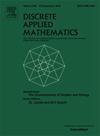The cyclic diagnosability of star graphs under the PMC and MM* models
IF 1
3区 数学
Q3 MATHEMATICS, APPLIED
引用次数: 0
Abstract
Although traditional connectivity and diagnosability have become relatively mature in assessing the reliability of multiprocessor systems, they often inadequately capture specific nuanced characteristics of these systems. In order to achieve a more comprehensive evaluation of the diagnostic capability of interconnection networks, Zhang et al. introduced a novel metric termed cyclic diagnosability. Within a system , the cyclic diagnosability of represents the maximum cardinality of a faulty vertex set that can be self-diagnosed, provided that is disconnected and encompasses at least two cycles, with each cycle belonging to a different component. This paper presents an analysis of the structural properties of star graphs. Additional, we ascertain that the cyclic diagnosability of the -dimensional star graph is , under PMC model and MM* model for . The size is nearly seven times that of the traditional diagnosability of star graphs.
求助全文
约1分钟内获得全文
求助全文
来源期刊

Discrete Applied Mathematics
数学-应用数学
CiteScore
2.30
自引率
9.10%
发文量
422
审稿时长
4.5 months
期刊介绍:
The aim of Discrete Applied Mathematics is to bring together research papers in different areas of algorithmic and applicable discrete mathematics as well as applications of combinatorial mathematics to informatics and various areas of science and technology. Contributions presented to the journal can be research papers, short notes, surveys, and possibly research problems. The "Communications" section will be devoted to the fastest possible publication of recent research results that are checked and recommended for publication by a member of the Editorial Board. The journal will also publish a limited number of book announcements as well as proceedings of conferences. These proceedings will be fully refereed and adhere to the normal standards of the journal.
Potential authors are advised to view the journal and the open calls-for-papers of special issues before submitting their manuscripts. Only high-quality, original work that is within the scope of the journal or the targeted special issue will be considered.
 求助内容:
求助内容: 应助结果提醒方式:
应助结果提醒方式:


